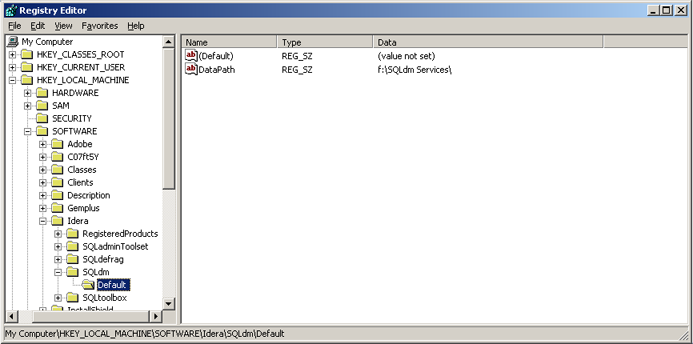Page History
...
- Select a disk that is configured in the Cluster Resource Group and create a folder on that disk that you want to use to hold local data for the services
- On the primary node, edit the registry and add a new key named Default to the key \SOFTWARE\Idera\SQLdm. In this key add a string value called DataPath. Set its value to the full path to the data directory created in step 1 (as shown in the image at the end of the steps)
- In the Failover Cluster Management tool, right-click on Services and Applications and select Configure a Service or Application
- Provide a name for the service
- Select Generic Service
- Select the SQLdm Management Service
- Enter the network name and IP address for the services
- Select the clustered storage that hosts the path defined in step 1
- Skip the Registry Replication
- Verify the settings and click Next to complete the wizard
- Repeat step 3 for the remaining SQLdm services.
- In Services and Applications, click the newly created service name in the Other Resources section and then on the SQLdm Management service and take it offline
- Select the SQLdm Management Service from the list of resources
- Select Next and Finish to exit the wizard
- In Services and Applications, right-click on the newly created service and then on the SQLdm Management Service and select Properties
- On the General tab, select Use Network Name for computer name
- On the Dependencies tab, add the name of service and disk, and then click Apply
- On the Registry Replication tab, if blank, add SOFTWARE\Idera\SQLdm\Default\DataPath
- In Services and Applications, right-click the newly created service and select Add a Resource and Generic Service
- Select the SQLdm Collection Service from the list of resources
- Select Next and Finish to exit the wizard
- In Services and Applications, right-click on the newly created service and then on the SQLdm Collection Service and select Properties
- On the General tab, select Use Network Name for computer name
- On the Dependencies tab, add name of service and disk, and then click Apply
- On the Registry Replication tab, add SOFTWARE\Idera\SQLdm\Default\DataPath
- In Services and Applications, right-click the newly created service and select Add a Resource and Generic Service
- Select the SQLdm Predictive Analytics service from the list of resources
- Select Next and then Finish to exit the wizard
- In Services and Applications, click the newly-created service and then on the SQLdm Predictive Analytics service and select Properties
- On the General tab, select Use Network Name for computer name
- On the Dependencies tab, add the name of the service and disk, and then click Apply
- On the Registry Replication tab, if blank, add SOFTWARE\Idera\SQLdm\Default\DataPath
- In Services and Applications, right-click the newly created service and select Add a Resource and Generic Service .
- Select the SQLdm Rest service from the list of resources
- Select Next and then Finish to exit the wizard
- In Services and Applications, click the newly-created service and then on the SQLdm Rest service and select Properties
- On the General tab, select Use Network Name for computer name
- On the Dependencies tab, add the name of the service and disk, and then click Apply
- On the Registry Replication tab, if blank, add SOFTWARE\Idera\SQLdm\Default\DataPath
- In Windows Services, bring the SQLdm Management service resource online
- In Windows Services, bring the SQLdm Collection service resource online
- In Windows Services, bring the SQLdm Predictive Analytics service resource online
- In Windows Services, bring the SQLdm Rest service resource online
- On the active node on which you installed the SQLdm services, use the Management Service Configuration wizard (Start > All Programs > IDERA> SQL Diagnostic Manager > Tools > Management Service Configuration Wizard) to force the services to re-register
- Test the configuration from the Management Service Configuration wizard before finishing the wizard
...
